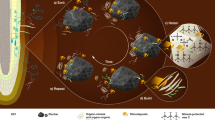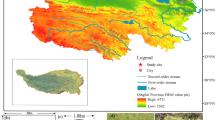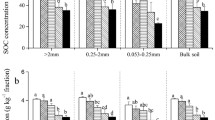Abstract
Coastal wetlands are increasingly recognized as important ecosystems for long-term carbon (C) storage. However, how soil aggregation mediates C accumulation and sequestration in these ecosystems remains unclear. Using the 13C isotope tracer from the invasion of a C4 plant, Spartina alterniflora, into the native ecosystem originally covered by C3 plants across Eastern Chinese coastal wetlands, we investigated a potential C stabilization process via soil structural protection. We quantified changes in soil aggregates, soil organic carbon (SOC), soil total nitrogen (STN), and natural 13C isotope abundance within aggregate fractions across a chronosequence of 0-, 4-, 8-, and 12-year S. alterniflora invasion. Our results showed that soil aggregate stability increased significantly along the chronosequence. Meanwhile, SOC and STN concentrations increased with invasion time in the whole soil and aggregate fractions, which were linked to increasing soil aggregate stability. The contribution of S. alterniflora-derived SOC increased from 18.96 to 40.24% in the 0–20 cm layer and from 4.66 to 32.04% in the 20–40 cm layer across the chronosequence from 4 to 12 years with the highest proportion observed in macro-aggregates. Our results indicate that invasion of S. alterniflora to coastal wetlands can sequester more C largely due to formation and stabilization of soil aggregates by soil structural protection.






Similar content being viewed by others
References
Abiven S, Menasseri S, Chenu C. 2009. The effects of organic inputs over time on soil aggregate stability: a literature analysis. Soil Biol Biochem 41:1–12.
Abramoff R, Xu X, Hartman M, O’Brien S, Feng W, Davidson E, Finzi A, Moorhead D, Schimel J, Torn M, Mayes MA. 2018. The Millennial model: in search of measurable pools and transformations for modeling soil carbon in the new century. Biogeochemistry 137:51–71.
Agrawal A, Nepstad D, Chhatre A. 2011. Reducing emissions from deforestation and forest degradation. Ann Rev Environ Resour 36:373–96.
Alongi DM. 2002. Present state and future of the world’s mangrove forests. Environ Conserv 29:33–49.
An SQ, Gu BH, Zhou CF, Wang ZS, Deng ZF, Zhi YB, Li HL, Chen L, Yu DH, Liu YH. 2007. Spartina invasion in China: implications for invasive species management and future research. Weed Res 47:183–91.
Balesdent J, Wagner GH, Mariotti A. 1988. Soil organic matter turnover in long-term field experiments as revealed by carbon-13 natural abundance. Soil Sci Soc Am J 52:118–24.
Barto EK, Alt F, Oelmann Y, Wilcke W, Rillig MC. 2010. Contributions of biotic and abiotic factors to soil aggregation across a land use gradient. Soil Biol Biochem 42:2316–24.
Bronick CJ, Lal R. 2005. Soil structure and management: a review. Geoderma 124:3–22.
Bull ID, van Bergen PF, Bol R, Brown S, Gledhill AR, Gray AJ, Harkness DD, Woodbury SE, Evershed RP. 1999. Estimating the contribution of Spartina anglica biomass to saltmarsh sediments using compound specific carbon isotope measurements. Org Geochem 30:477–83.
Buyanovsky GA, Aslam M, Wagner GH. 1994. Carbon turnover in soil physical fractions. Soil Sci Soc Am J 58:1167–73.
Cécillon L, de Mello NA, De Danieli S, Brun JJ. 2010. Soil macroaggregate dynamics in a mountain spatial climate gradient. Biochemistry 97:31–43.
Chambers LG, Guevara R, Boyer JN, Troxler TG, Davis SE. 2016. Effects of salinity and inundation on microbial community structure and function in a mangrove peat soil. Wetlands 36:361–71.
Chen ZY, Li B, Zhong Y, Chen JK. 2004. Local competitive effects of introduced Spartina alterniflora on Scirpus mariqueter at Dongtan of Chongming Island, the Yangtze River estuary and their potential ecological consequences. Hydrobiologia 528:99–106.
Cheng XL, Luo YQ, Chen JQ, Lin GH, Chen JK, Li B. 2006. Short-term C4 plant Spartina alterniflora invasions change the soil carbon in C3 plant dominated tidal wetlands on a growing estuarine island. Soil Biol Biochem 38:3380–6.
Cheng XL, Chen JQ, Luo YQ. 2008. Assessing the effects of short-term Spartina alterniflora invasion on labile and recalcitrant C and N pools by means of soil fractionation and stable C and N isotopes. Geoderma 145:177–84.
Chiang PN, Wang MK, Chiu CY, King HB, Hwong JL. 2004. Change in the grassland-forest boundary at Ta-Ta-Chia long term ecological research (LTER) site detected by stable isotope ratio of soil organic matter. Chemosphere 54:217–24.
Chmura GL, Anisfeld SC, Cahoon DR, Lynch JC. 2003. Global carbon sequestration in tidal, saline wetland soils. Glob Biogeochem Cycles 17:1111.
Choi Y, Wang Y. 2004. Dynamics of carbon sequestration in a coastal wetland using radiocarbon measurements. Glob Biogeochem Cycles 18:4016.
Christensen BT. 2001. Physical fractionation of soil and structural and functional complexity in organic matter turnover. Eur J Soil Sci 52:345–53.
Clemmensen KE, Bahr A, Ovaskainen O, Dahlberg A, Ekblad A, Wallander H, Stenlid J, Finlay RD, Wardle DA, Lindahl BD. 2013. Roots and associated fungi drive long-term carbon sequestration in boreal forest. Science 339:1615–18.
Deegan LA, Johnson DS, Warren RS, Peterson BJ, Fleeger JW, Fagherazzi S, Wollheim WM. 2012. Coastal eutrophication as a driver of salt marsh loss. Nature 490:388–92.
Denef K, Six J, Merckx R, Paustian K. 2002. Short-term effects of biological and physical forces on aggregate formation in soils with different clay mineralogy. Plant Soil 246:185–200.
Desjardins T, Carneirofilho A, Mariotti A, Chauvel A, Girardin C. 1996. Changes of the forest-savanna boundary in Brazilian Amazonia during the Holocene revealed by stable isotope ratio of soil organic carbon. Oecologia 108:749–56.
Desjardins T, Folgarait PJ, Pando-Bahuon A, Girardin C, Lavelle P. 2006. Soil organic matter dynamics along a rice chronosequence in north-eastern Argentina: evidence from natural 13C abundance and particle size fractionation. Soil Biol Biochem 38:2753–61.
Donato DC, Kauffman JB, Murdiyarso D, Kurnianto S, Stidham M, Kanninen M. 2011. Mangroves among the most carbon-rich forests in the tropics. Nat Geosci 4:293–7.
Duarte CM, Middelburg J, Caraco N. 2005. Major role of marine vegetation on the oceanic carbon cycle. Biogeosciences 2:1–8.
Duarte CM, Losada IJ, Hendriks IE, Mazarrasa I, Marba N. 2013. The role of coastal plant communities for climate change mitigation and adaptation. Nat Clim Change 3:961–8.
Duiker SW, Rhoton FE, Torrent J, Smeck NE, Lal R. 2003. Iron (hydr)oxide crystallinity effects on soil aggregation. Soil Sci Soc Am J 67:606–11.
Fourqurean JW, Duarte CM, Kennedy H, Marbà N, Holmer M, Mateo MA, Apostolaki ET, Kendrick GA, Krause-Jensen D, McGlathery KJ. 2012. Seagrass ecosystems as a globally significant carbon stock. Nat Geosci 5:505–9.
Franzluebbers AJ, Arshad MA. 1997. Particulate organic carbon content and potential mineralization as affected by tillage and texture. Soil Sci Soc Am J 61:1382–6.
Gale W, Cambardella C, Bailey T. 2000. Root-derived carbon and the formation and stabilization of aggregates. Soil Sci Soc Am J 64:201–7.
Gebrehiwet T, Koretsky MC, Krishnamurthy RV. 2008. Influence of Spartina and Juncus on salt marsh sediments. III. Organic geochemistry. Chem Geol 255:114–19.
Golchin A, Baldock JA, Oades JM. 1997. A model linking organic matter decomposition, chemistry, and aggregate dynamics. In: Lal R, Kimble JM, Follett RF, Stewart BA, Eds. Soil processes and the carbon cycle. New York: CRC Press. p 245–66.
Graves CJ, Makrides EJ, Schmidt VT, Giblin AE, Cardon ZG, Rand DM. 2016. Functional responses of salt marsh microbial communities to long-term nutrient enrichment. Appl Environ Microbiol 82:2862–71.
Green EP, Short FT. 2003. World atlas of seagrasses. Berkeley (CA): California University Press.
Harvey HR, Mannino A. 2001. The chemical composition and cycling of particulate and macromolecular dissolved organic matter in temperate estuaries as revealed by molecular organic tracers. Org Geochem 32:527–42.
Hemminga MA, Cattrijsse A, Wielemaker A. 1996. Bedload and nearbed detritus transport in a tidal saltmarsh creek. Estuar Coast Shelf Sci 42:55–62.
IPCC. 2013. Climate change 2013: the physical science basis. Contribution of working group I to the fifth assessment report of the intergovernmental panel on climate change. Cambridge: Cambridge University Press.
Jastrow JD. 1996. Soil aggregate formation and the accrual of particulate and mineral-associated organic matter. Soil Biol Biochem 28:665–76.
Jastrow JD, Boutton TW, Miller RM. 1996. Carbon dynamics of aggregate-associated organic matter estimated by carbon-13 natural abundance. Soil Sci Soc Am J 60:801–7.
Jastrow JD, Miller RM, Lussenhop J. 1998. Contributions of interacting biological mechanisms to soil aggregate stabilization in restored prairie. Soil Biol Biochem 30:905–16.
Jenkinson DS, Coleman K. 2008. The turnover of organic carbon in subsoils. Part 2. Modelling carbon turnover. Eur J Soil Sci 59:400–13.
Kelleway JJ, Saintilan N, Macreadie PI, Ralph PJ. 2016. Sedimentary factors are key predictors of carbon storage in SE Australian saltmarshes. Ecosystems 19:865–80.
Kemper WD, Rosenau RC. 1986. Aggregate stability and size distribution. In: Klute A, Ed. Methods of Soil Analysis. Part 1. 2nd ednAgron. Monogr. 9, Madison (WI): ASA. p 425–42.
Kennedy H, Beggins J, Duarte CM et al. 2010. Seagrass sediments as a global carbon sink: isotopic constraints. Global Biogeochem Cycles 24:57. https://doi.org/10.1029/2010gb003848.
Killham K, Amato M, Ladd JN. 1993. Effect of substrate location in soil and soil pore-water regime on carbon turnover. Soil Biol Biochem 25:57–62.
Kirwan ML, Megonigal JP. 2013. Tidal wetland stability in the face of human impacts and sea-level rise. Nature 504:53–60.
Koven CD, Riley WJ, Subin ZM et al. 2013. The effect of vertically resolved soil biogeochemistry and alternate soil C and N models on C dynamics of CLM4. Biogeosciences 10:7109–31.
Kristensen E, Bouillon S, Dittmar T, Marchand C. 2008. Organic carbon dynamics in mangrove ecosystems: a review. Aquat Bot 89:201–19.
Krull ES, Baldock JA, Skjemstad JO. 2003. Importance of mechanisms and processes of the stabilisation of soil organic matter for modelling carbon turnover. Funct Plant Biol 30:207–22.
Liao JD, Boutton TW, Jastrow JD. 2006. Storage and dynamics of carbon and nitrogen in soil physical fractions following woody plant invasion of grassland. Soil Biol Biochem 38:3184–96.
Liao C, Luo Y, Jiang L, Zhou X, Wu X, Fang C, Chen J, Li B. 2007. Invasion of Spartina alterniflora enhanced ecosystem carbon and nitrogen stocks in the Yangtze estuary, China. Ecosystems 10:1351–61.
Liao C, Peng R, Luo Y, Zhou X, Wu X, Fang C, Chen J, Li B. 2008. Altered ecosystem carbon and nitrogen cycles by plant invasion: a meta-analysis. New Phytol 177:706–14.
Lin GH, Ehleringer JR, Rygiewicz PT, Johnson MG, Tingey DT. 1999. Elevated CO2 and temperature impacts on different components of soil CO2 efflux in Douglas-fir terracosms. Glob Change Biol 5:157–68.
Luo Y, Ahlström A, Allison SD et al. 2015. Towards more realistic projections of soil carbon dynamics by earth system models. Glob Biogeochem Cycles . https://doi.org/10.1002/2015gb005239.
Ma Z, Melville DS, Liu J, Chen Y, Yang H, Ren W, Zhang Z, Piersma T, Li B. 2014. Rethinking China’s new great wall. Science 346:912–14.
Mcleod E, Chmura GL, Bouillon S, Salm R, Björk M, Duarte C, Lovelock CE, Schlesingers WH, Silliman BR. 2011. A blueprint for blue carbon: toward an improved understanding of the role of vegetated coastal habitats in sequestering CO2. Front Ecol Environ 7:362–70.
Morel JL, Habib L, Plantureux S. 1991. Influence of maize root mucilage on soil aggregate stability. Plant Soil 136:111–19.
Neubauer SC. 2008. Contributions of mineral and organic components of tidal freshwater marsh accretion. Estuar Coast Shelf Sci 78:78–88.
Oades JM, Waters AG. 1991. Aggregate hierarchy in soils. Aust J Soil Res 29:815–28.
Qin P, Zhong CX. 1992. Applied studies on Spartina. London: Ocean Press.
Roulet NT. 2000. Peatlands, carbon storage, greenhouse gases, and the Kyoto Protocol: prospects, and significance for Canada. Wetlands 20:605–15.
Rovira P, Vallejo VR. 2002. Labile and recalcitrant pools of carbon and nitrogen in organic matter decomposing at different depths in soil: an acid hydrolysis approach. Geoderma 107:109–41.
Salome C, Nunan N, Poteau R, Lerch TZ, Chenu C. 2010. Carbon dynamics in topsoil and in subsoil may be controlled by different regulatory mechanisms. Glob Change Biol 16:416–26.
Six J, Jastrow JD. 2002. Organic matter turnover. In: Lal T, Ed. Encyclopedia of soil science. New York: Marcel Dekker. p 936–42.
Six J, Elliott ET, Paustian K, Doran JW. 1998. Aggregation and soil organic matter accumulation in cultivated and native grassland soils. Soil Sci Soc Am J 62:1367–76.
Six J, Paustian K, Elliott ET, Combrink C. 2000a. Soil structure and organic matter: I. Distribution of aggregate-size classes and aggregate-associated carbon. Soil Sci Soc Am J 64:681–9.
Six J, Elliott ET, Paustian K. 2000b. Soil macroaggregate turnover and microaggregate formation: a mechanism for C sequestration under no-tillage agriculture. Soil Biol Biochem 32:2099–103.
Six J, Conant RT, Paul EA, Paustian K. 2002. Stabilization mechanisms of soil organic matter: implications for C-saturation of soils. Plant Soil 241:155–76.
Six J, Bossuyt H, Degryze S, Denef K. 2004. A history of research on the link between (micro) aggregates, soil biota, and soil organic matter dynamics. Soil Tillage Res 79:7–31.
Sun T, Chen Q, Chen Y, Cruse R, Li X, Song C, Kravchenko Y, Zhang X. 2014. A novel soil wetting technique for measuring wet stable aggregates. Soil Tillage Res 141:19–24.
Tisdall JM, Oades JM. 1982. Organic matter and water-stable aggregates in soils. J Soil Sci 33:141–63.
Wang Q, An SQ, Ma ZJ, Zhao B, Chen JK, Li B. 2006. Invasive Spartina alterniflora: biology, ecology, and management. Acta Phytotaxon Sin 44:559–88.
Wang D, Zhang R, Xiong J, Guo HQ, Zhao B. 2015. Contribution of invasive species Spartina alterniflora to soil organic carbon pool in coastal wetland: stable isotope approach. Chin J Plant Ecol 39:941–9 (in Chinese, with English abstract).
Wilson GWT, Rice CW, Rillig MC, Springer A, Hartnett DC. 2009. Soil aggregation and carbon sequestration are tightly correlated with the abundance of arbuscular mycorrhizal fungi: results from long-term field experiments. Ecol Lett 12:452–61.
Windham L, Ehrenfeld JG. 2003. Net impact of a plant invasion on nitrogen-cycling processes within a brackish tidal marsh. Ecol Appl 13:883–97.
Wooller M, Smallwood B, Jacobson M, Fogel M. 2003. Carbon and nitrogen stable isotopic in Laguncularia racemosa (L.) (white mangrove) from Florida and Belize: implications for trophic level studies. Hydrobiologia 499:13–23.
Yang SG, Li JH, Zheng Z, Meng Z. 2009. Characterization of Spartina alterniflora as feedstock for anaerobic digestion. Biomass Bioenergy 33:597–602.
Yang W, Jeelani N, Leng X, Cheng XL, An XQ. 2016. Spartina alterniflora invasion alters soil microbial community composition and microbial respiration following invasion chronosequence in a coastal wetland of China. Sci Rep 6:26880. https://doi.org/10.1038/srep26880.
Zhang YH, Ding WX, Luo JF, Donnison A. 2010. Changes in soil organic carbon dynamics in an Eastern Chinese coastal wetland following invasion by a C4 plant Spartina alterniflora. Soil Biol Biochem 42:1712–20.
Zhao B, Yan Y, Guo HQ, He MM, Gu YJ, Li B. 2009. Monitoring rapid vegetation succession in estuarine wetland using time series MODIS-based indicators: an application in the Yangtze River Delta area. Ecol Indic 9:346–56.
Zuazo VHD, Pleguezuelo CRR. 2008. Soil-erosion and runoff prevention by plant covers: a review. Agron Sustain Dev 28:65–86.
Acknowledgements
This study was carried out at the Chongming Dongtan Nature Reserve, Shanghai. We acknowledge the practical help provided by Dan Wang, Qin Wang, and Haiqiang Guo. We thank Ming Li, Zhenggang Du, Yuanyuan Nie, and Xi Yang for assistance with field work. We would also like to thank anonymous reviewers for their critical comments/suggestions which improved the quality of the manuscript. This research was financially supported by the National Natural Science Foundation of China (Grant Nos. 31770559, 31370489, and 31600352), the Program for Professor of Special Appointment (Eastern Scholar) at Shanghai Institutions of Higher Learning, and “Thousand Young Talents” Program in China.
Author information
Authors and Affiliations
Corresponding author
Additional information
Author Contributions
YH, XZ, LZ, and JS designed this experimental study. YH, WC, RL, and GZ performed the research. YH analyzed the data. YH, XZ, KZ, and WC wrote the manuscript, and all authors substantially contributed to the revision.
Electronic supplementary material
Below is the link to the electronic supplementary material.
Rights and permissions
About this article
Cite this article
He, Y., Zhou, X., Cheng, W. et al. Linking Improvement of Soil Structure to Soil Carbon Storage Following Invasion by a C4 Plant Spartina alterniflora. Ecosystems 22, 859–872 (2019). https://doi.org/10.1007/s10021-018-0308-3
Received:
Accepted:
Published:
Issue Date:
DOI: https://doi.org/10.1007/s10021-018-0308-3




